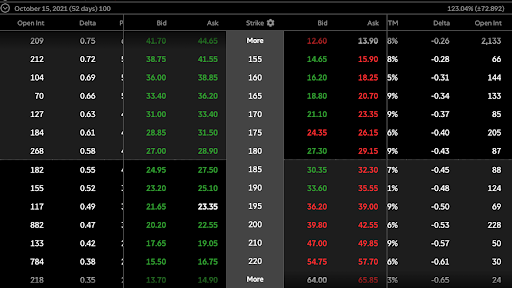What is options trading?
Options are a financial derivative: a product that derives its value from another underlying investment. As the name implies, options give you the option (not a requirement) to buy an investment at a specific price on a future date.
Investments are a fairly advanced investment product. Many brokerages require customer approval and place limits on the ability to trade options. Newer options traders may be limited to call and put options, while more experienced traders could access more advanced and riskier options strategies.
Because options can be complex, it’s best to get a lot of experience with puts and call before exploring more exotic trades such as the excitingly named “iron condor” or the “reverse iron albatross spread.” When you focus on basic call and put options, it’s easier to understand what you’re doing and limit your potential losses.
Invest in real estate without the headache of being a landlord
Imagine owning a portfolio of thousands of well-managed single family rentals or a collection of cutting-edge industrial warehouses. You can now gain access to a $1B portfolio of income-producing real estate assets designed to deliver long-term growth from the comforts of your couch.
The best part? You don’t have to be a millionaire and can start investing in minutes.
Learn MoreHow options work
In most cases, options investors pay an up-front fee to buy the option. You can view options for a specific security on an options chain, a visual display that shows you currently available options for that stock or commodity.
Call options give you the right to buy a security at a specific future price, indicating that you think the price of an asset will increase between buying the option and the exercise date. Put options give you the option to sell an asset, similar to short selling, where you profit if the asset value falls. Every contract gives you the right to buy or sell 100 shares.
If the underlying investment is worth more than the agreed upon purchase price (also known as the strike price), the option is considered “in the money” and exercising it will yield a profit. Conversely, if the investment is worth less than the strike price, the investment is “out of the money” and expires unprofitable, with the initial cost considered an investment loss.
Options vs. futures: Options give you a choice to buy or sell an asset on a specific future date, while futures contracts require you to buy or sell on the specific future date. This makes options less risky than futures in most situations.
Why use options instead of investing in an asset directly?
You may be wondering why you would want to buy call or put options instead of directly buying the stock or other asset. The answer is all about controlling investment risk.
If you buy or short sell a stock, you have to live with the results of an investment that goes up or down. Further, your gains (and losses) are limited to the amount of stock you can afford, not including margin borrowing. Options change that formula in a way that can benefit certain investment strategies.
Buying options can limit your losses. When you trade put and call options, the most you can lose is the amount you pay for the option. When you invest in an asset directly, your entire investment is at risk.
Another reason to use options is for leverage. Each option contract represents 100 shares of the asset. If you have strong convictions that an asset will go up or down, you can 100x your investment exposure using options. For example, if you buy one contract for a stock and it goes up $1 per share, your options contract earns $100. That’s an exciting prospect for some traders, particularly those with a shorter-term investment outlook.
Retire richer: The secret to building wealth faster
Most people miss out on key opportunities to grow their wealth. Partnering with the right financial advisor can help you secure a brighter future. Learn how to make your money work harder for you today.
Discover the secretOptions trading strategies
Options trading can be complex. Because there’s a big risk of losses, many brokerages require customers to apply before trading options.
Here’s a look at some of the most common options trading strategies using call options and put options.
Call options vs. put options
-
Covered calls: These give you the right to purchase an asset you already own in your stock portfolio at a specific price on a future date. Covered calls are the least risky call option and are best for newer options traders who think an asset price will go up between now and the exercise date. This is a hedging strategy to limit losses.
-
Covered puts: This strategy enables you to sell an asset at a specific date in the future. These are a good way for newer options traders to test strategies where they believe a stock, commodity, currency or other asset will go down in value. Like covered calls, you own an investment in the asset before buying a covered put to limit your losses or hedge your existing investment.
-
Long calls and puts: Long calls and puts are similar to covered calls and puts, but you don’t already own the underlying asset. This is the most common type of option you’ll trade as a beginner in most cases.
-
Uncovered calls and puts: These work similarly to other strategies but are riskier. Uncovered options are best for experienced traders, as they come with the potential for higher losses. Many brokerages don’t enable uncovered options trading for newer customers or those with less experience.
How to trade call and put in options trading
Trading options is a fairly straightforward process once you understand the underlying mechanics. Here are the main steps to get started:
- Open a brokerage account: Start by choosing and opening a brokerage account if you don’t already have one. Pay close attention to fees and pricing if you plan on active options trading. Here’s a look at our favorite brokerages if you don’t have one already.
- Fund your account: You’ll need cash in your account to buy the option. So fund your account with sufficient funds for your trading strategy.
- Request options privileges: Once your account is up and running, you can request options trading privileges. As shown above, some brokerages offer incremental trading abilities as your experience improves.
- Enter your first options trade: Now it’s time to enter a trade! See an example of how that works below.
- Exercise your option if it’s in the money: Keep close tabs on your options account, as options can be quite volatile. Be prepared to make an informed decision, or to sell early if it seems prudent, as your expiry date approaches.
Example: Amazon.com call option
To get a clear idea of how an options trade works, here’s an example for Amazon.com.
As of this writing, the price for a single share of Amazon is $3,302.09. The order pictured below would give you exposure to 100 shares of Amazon at $3,300 per share with an expiration date of June 17, 2022, for a price of $306.30.
If you were to buy this option, the Amazon share price must be around $3,303 to break even. Assuming the stock price is $3,304 on the expiration date, you would earn a profit of about $94. If the price is higher, you make more. But if the stock price is $3,303 or below, you would be better off letting the option expire without exercising it, and your total loss would be the $306.30 paid for the contract.
How to buy and sell calls or puts
You can buy and sell calls and puts through your brokerage account. Most modern brokers feature web trading platforms and mobile apps. The best brokers also offer dedicated active trading software for your desktop or laptop computer.
Entering an order is similar to buying or selling a stock. However, you could have additional fields with more trading features, as well as the ability to manipulate or put conditions around your trade. For basic orders, refer to the general five steps above in the section “How to Trade Call and Put in Options Trading.” For more detailed steps, visit your brokerage website for step-by-step instructions on using its trading platform.
Short-term options vs. long-term options
Short-term and long-term options are the same thing, but with different expiration timelines. Many traders consider options maturing in the next few weeks to be short-term, and further dates to be long-term.
Short-term option prices typically follow the current stock or asset price very closely, while longer-term options may vary more as investors expect the stock to go up or down. Each has different risks, so it’s important to consider the potential upside and downside before buying options.
How to read options tables
Most brokerages show a table with call and put prices called an options chain. The table generally features important data that includes the most commonly-used numbers. Your brokerage may allow you to edit the table to include more information you consider relevant to your trading strategy.

Common data you’ll find on an option tables include:
Symbols: Similar to stocks, every option has a unique symbol. The symbol tells you the asset, option type, expiration and strike price in a single line of data.
Strike price: The strike price is the contract price you’ll pay for the asset if you exercise the option.
Last: Most tables show the most recent price paid for the specific option under a column called “last” or similar.
Change: Change tells you the daily change in value for the option compared to the prior day.
Bid: The bid price is the current amount someone is willing to pay for an option through an existing open order.
Ask: The ask price is how much someone is willing to sell an option through an existing open order.
Volume: Volume tells you how many times an option has traded during the current session.
Open Interest: This tells you the number of open positions for a specific contract that have not yet been filled or offset.
What are long calls and puts?
Long calls and puts are not necessarily the same as long-term calls and puts. Confusing, right?
In options trading, as with stock investing, “long” means you are investing expecting an asset price to go up. “Short” would mean you’re bearish on the asset and think it will go down. The term is also similar to short selling stocks, a trade in which you expect a stock price to go down.
Options risks and benefits
You experience relatively little risk compared to other options with covered calls and puts, which makes them a good starting place for new options traders. Other options trading styles, however, can be extremely risky.
If you know what you’re doing and have a specific goal, adding options to your portfolio may be a good choice.
For the typical investor, though, options are not a good choice. There are stories of traders accidentally losing hundreds of thousands of dollars trading options, some even ending tragically. Enter the world of options trading with care.
When used correctly, however, options are a great way to gain market exposure while limiting your risk. You may use an option to buy a risky stock you think will rise instead of buying it directly, for example. You could also buy options to offset other portfolio risks or capture a gain from a specific set of market circumstances.
Before investing, decide whether the potential gains and benefits outweigh the risks for your specific investing goals.
The bottom line: is options trading for you?
For the average investor, skipping options altogether may be best. It’s better to avoid investments you don’t need or fully understand. Options can be high risk, so they’re certainly not right for everyone.
However, options trading is a fun and exciting way to actively engage with the markets. If you’re into the highs and lows of active trading, options could be an interesting addition to your investment mix. Or, if you want to take more control over your risk profile, you could add options calls and puts in your investment toolbox.
Now that you know how to trade options, it’s up to you to decide what to do next.
The richest 1% use an advisor. Do you?
Wealthy people know that having money is not the same as being good with money. Advisor.com can help you shape your financial future and connect with expert guidance . A trusted advisor helps you make smart choices about investments, retirement savings, and tax planning.
Try it now








